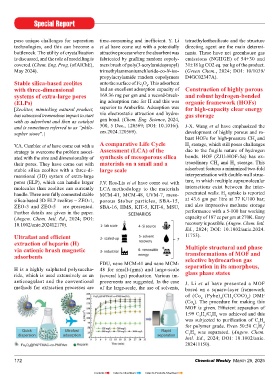Page 172 - CW E-Magazine (25-3-2025)
P. 172
Special Report
pose unique challenges for separation time-consuming and ineffi cient. Y. Li tetraethylorthosilicate and the structure
technologies, and this can become a et al have come out with a potentially directing agent are the main determi-
bottleneck. The utility of crystallisation attractive process where the absorbent was nants. These have net greenhouse gas
is discussed, and the role of modelling is fabricated by grafting random copoly- emissions (NGHGE) of 54±30 and
covered. (Chem. Eng. Prog. (of AIChE), mers brush of poly(3-acrylamidopropyl) 31±18 kg CO2 eq. per kg of the product.
May 2024). trimethylammoniumchloride-co-N-iso- (Green Chem., 2024; DOI: 10/1039/
propylacrylamide random copolymers D4GC02347A).
Stable silica-based zeolites onto the surface of Fe O . This adsorbent
4
3
with three-dimensional had an excellent adsorption capacity of Construction of highly porous
systems of extra-large pores 169.36 mg per gm and a record-break- and robust hydrogen-bonded
(ELPs) ing adsorption rate for H and this was organic framework (HOFs)
[Zeolites, mimicking natural product, superior to Amberlite. Adsorption was for high-capacity clear energy PRODUCT RANGE
has witnessed tremendous impact to start via electrostatic attraction and hydro- gas storage
with as adsorbent and then as catalyst gen bond. (Chem. Eng. Science, 2024,
and is sometimes referred to as “philo- 300, 5 Dec., 120569; DOI: 10.1016/j. J-X. Wang et al have emphasized the
sopher stone”.] ces.2024.120569). development of highly porous and ro-
bust HOFs for high-pressure CH and
4
V.A. Camblor et al have come out with a A comparative Life Cycle H storage, which still poses challenges
2
strategy to overcome the problem associ- Assessment (LCA) of the due to the fragile nature of hydrogen
ated with the size and dimensionality of synthesis of mesoporous silica bonds. HOF (ZJU-HOF-5a) has ex-
their pores. They have come out with materials on a small and a traordinary CH and H storage. This
2
4
stable silica zeolites with a three-di- large scale adsorbent features a minimized two-fold
mensional (3D) system of extra-large interpenetration with double-wall struc-
pores (ELP), which can handle larger J.V. Ros-Lis et al have come out with ture, in which multiple supramolecular
molecules than zeolites can currently LCA methodology to the materials interactions exist between the inter-
handle. Three new fully connected stable MCM-41, MCM-48, UVM-7, meso- penetrated walls. H uptake is reported
2
silica-based 3D ELP zeolites – ZEO-1, porous Stober particles, SBA-15, at 43.6 gm per litre at 77 K/100 bar;
ZEO-3 and ZEO-5 – are presented. SBA-16, HMS, KIT-5, KIT-6, MSU, and also impressive methane storage
Further details are given in the paper. performance with a 5-100 bar working
(Angew. Chem. Intl. Ed., 2024; DOI: capacity of 187 cc per gm at 270K. Easy
10.1002/anie.202412170). recovery is possible. (Angew. Chem. Intl.
Ed., 2024; DOI: 10.1002/anie.2024.
Ultrafast and effi cient 11753).
extraction of heparin (H)
via cationic brush magnetic Multiple structural and phase
adsorbents transformations of MOF and
selective hydrocarbon gas
FDU, nano MCM-41 and nano MCM- separation in its amorphous,
H is a highly sulphated polysaccha- 48 for small-(gms) and large-scale
ride, which is used extensively as an (several kgs) production. Various im- glass phase states
anticoagulant and the conventional provements are suggested. In the case J. Li et al have presented a MOF
methods for extraction processes are of the large-scale, the use of solvents, based on a square-layer framework
of (Co (Pybz) (CH COO) ) DMF
2
2
2
3
(Co ). The procedure for making this
2
MOF is given. Effi cient separation of
1:99 C H /C H was achieved and this
2
2
4
2
was subjected to purifi cation of C H
4
2
for polymer grade. Even 50:50 C H /
3
6
C H was separated. (Angew. Chem.
8
3
Intl. Ed., 2024; DOI: 10.1002/anie.
202411150).
172 Chemical Weekly March 25, 2025
Contents Index to Advertisers Index to Products Advertised

